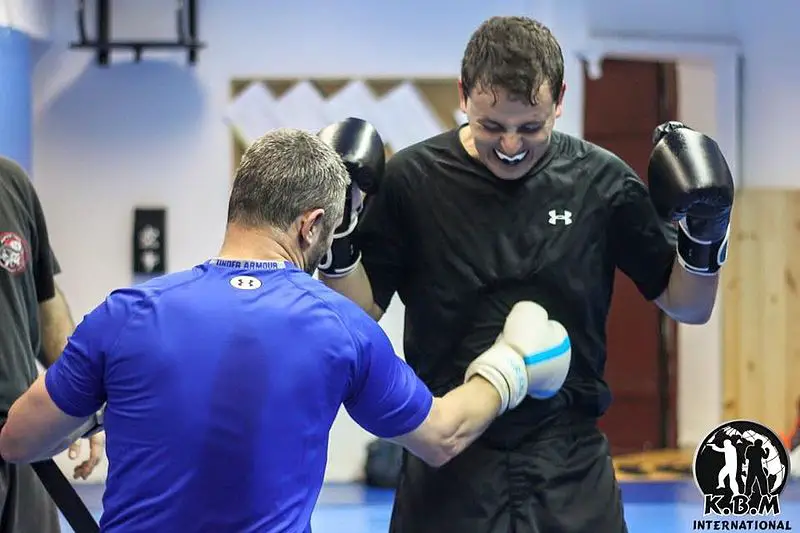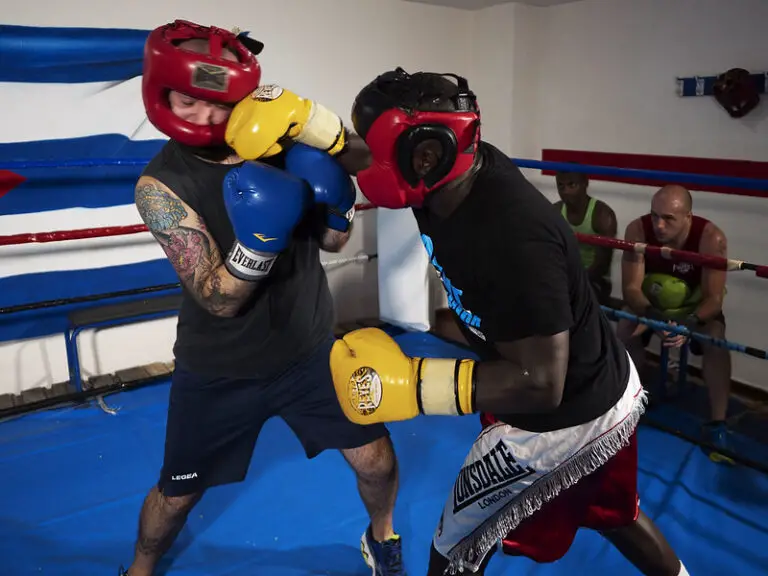Sparring is a key component of boxing training and many beginners and people looking to enroll in boxing wonder what are the benefits of this training method.
So in this article, we are going to explore why sparring is important, what are the benefits, how this realistic training method enhances your skills, and why you should do it if you are serious about developing proper boxing skills.
Teaches Practical Application of Techniques
Learning the correct technique on the heavy bag is good for muscle memory. However, using these skills and techniques against a fully resisting opponent is different. You need boxing sparring to learn this.
This dynamic setting provides invaluable feedback that simply cannot be replicated through solo drills or shadowboxing.

In sparring, boxers must adapt to their opponent’s reactions. While a heavy bag stands in place most of the time, the opponent is moving. You must know how to coordinate your movements and land shots against the moving target.
This adaptive process strengthens their ability to think critically and make split-second decisions. A skill that is paramount in the fluid and unpredictable environment of a boxing match.
Teaches Stress Response and Emotional Control
Sparring teaches you how to stay calm under pressure and control your fears. Everyone is afraid of being hurt, that’s normal. But the way we respond to those fears makes a lot of difference.
Some people freeze or become overly aggressive, which is bad. In any type of fight, you need to stay calm and have a clear mind to make rational decisions. This decision includes acknowledging the fear and putting it under control.
For example, when faced with an aggressive opponent during sparring, a boxer learns to manage their adrenaline, control their fear, and maintain composure to make strategic decisions. It is normal to be afraid in the first couple of sessions.
But over time, this practice helps them develop the mental resilience needed to stay calm and focused during actual fights, enabling clearer thinking and better performance under pressure.
Prepares the body to absorb damage and ignore pain
Sparring exposes boxers to physical impact, helping them condition their bodies to absorb punches and endure discomfort. Through repeated exposure to controlled hits, boxers gradually build up tolerance to pain and learn to ignore it during intense exchanges.
Over time, this process allows them to stay focused on their strategy and continue fighting. Upon being hit, their mind and body will recognize it is the same impact they absorbed hundreds of times in the gym. Thus, the mind won’t enter a panic mode and will treat this as any other hit absorbed in the gym.

Sparring also teaches boxers how to manage pain effectively. Rather than succumbing to discomfort, they learn to channel their focus into their technique and game plan.
This mental discipline allows them to push through the discomfort and maintain their performance, even when facing adversity in the ring.
Also, sparring teaches damage prevention with proper defensive skills. This includes blocking, parrying, head movement and other defensive manoeuvres.
Timing and Distance Development
Sparring enhances a boxer’s timing and feeling for distance. It teaches them how to gauge the distance between themselves and their opponent, crucial for landing punches effectively while avoiding counterattacks.
In sparring, boxers develop an intuitive sense of timing and distance through repeated engagement with live opponents. They learn to anticipate their opponent’s movements, recognizing patterns that signal openings for attacks or opportunities to evade incoming strikes.
This heightened awareness allows boxers to effectively control the space between themselves and their opponent, optimizing their positioning for offensive strikes while simultaneously evading potential counterattacks.
Understanding Strategies and Tactics
Through sparring, boxers gain a deeper understanding of various strategies and tactics. They learn how to read opponents, anticipate movements, and adjust their own tactics accordingly. Doing shadowboxing, you can only visualize this, which is not enough.
When sparring, boxers need to think fast and try to outsmart their partner. By facing different styles and situations, they learn to predict what their opponent might do and plan their own moves accordingly. This helps them become smarter fighters, ready to adapt to any situation in the ring.
They become like chess players, strategizing their next moves based on their opponent’s actions. They learn to read subtle cues and anticipate punches, footwork, and defensive manoeuvres.
This sharpens their ability to think on their feet and adjust their tactics in real time. Through experience in the ring, they develop a tactical toolbox that they can draw from in competitive bouts, giving them an edge over opponents who may not have had the same level of exposure to different styles and strategies.
Competition Preparation
Sparring serves as a vital component of competition preparation. It allows boxers to simulate the intensity and pressure of actual fights. This includes physical, mental and technical preparation.
First, sparring enables boxers to master specific techniques. In a controlled environment, they can get insight into all the holes in their game and work hard on making corrections. It’s always better to expose all the weaknesses in training than in competition.
Next, sparring replicates the intensity and pressure of a real fight, helping them get accustomed to the adrenaline rush and mental demands of competition. After hundreds of sparring rounds, competing in a match would feel natural to them. This enables a boxer to stay focused on the task ahead and avoid any distractions.
This preparation is essential for ensuring that they are physically and mentally ready to perform at their best when it counts in the ring.
Improves Self-Defense Skills
Sparring against a fully resisting opponent hones a boxer’s self-defence skills. It teaches them how to defend themselves in real-life situations where the opponent is actively trying to land punches.
Like preparing for competition, a heavy bag does not return punches. You need to spar regularly to learn how to apply techniques. In other words, to learn how to fight against different types of people. More importantly, to train your mind and body to absorb physical damage and learn how to respond effectively.
If you don’t spar, you will never know how would you react in a real situation. Would you freeze out of fear? Would you be able to hit the target? How you are going to react when the attacker hits you with a hard shot to the face? These are all hypothetical questions you can’t answer without sparring.
Thus, if your goal is to learn boxing for self-defense, you need to spar. Each legitimate self-defense martial art includes some type of realistic teaching method where students do live drills.
Is Boxing Dangerous For Beginners?
Can You Learn Boxing Without Sparring?
Yes, it’s possible to learn the fundamentals of boxing without sparring.
Many beginners start their boxing journey by focusing on developing basic techniques such as footwork, stance, punches, and defensive manoeuvres through shadow boxing, bag work, and pad work.
These activities help build muscle memory, improve coordination, and enhance overall fitness without the need for direct contact with an opponent.
However, this won’t prepare you for real combat inside the ring or self-defence in the real world. Training without sparring only allows you to develop proper technique and form and learn the basics, which does not guarantee you that you will be able to use these skills in a real fight.
In order to learn how to fight, you need to spar on a regular basis.


